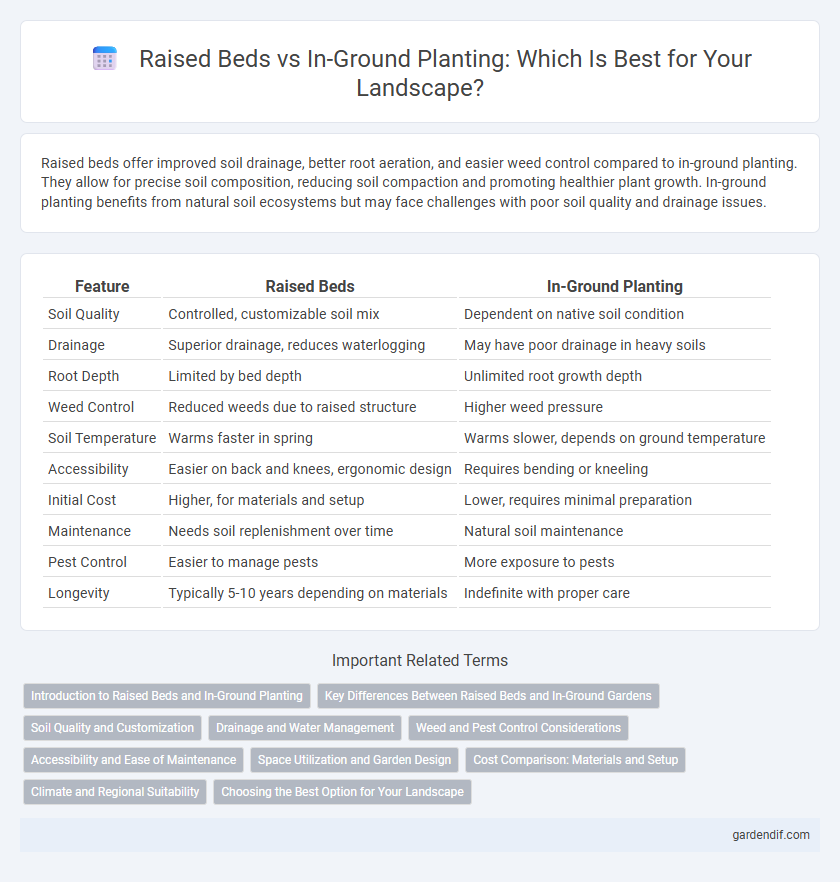
Raised Beds vs In-Ground Planting Illustration
Raised beds offer improved soil drainage, better root aeration, and easier weed control compared to in-ground planting. They allow for precise soil composition, reducing soil compaction and promoting healthier plant growth. In-ground planting benefits from natural soil ecosystems but may face challenges with poor soil quality and drainage issues.
Table of Comparison
| Feature | Raised Beds | In-Ground Planting |
|---|---|---|
| Soil Quality | Controlled, customizable soil mix | Dependent on native soil condition |
| Drainage | Superior drainage, reduces waterlogging | May have poor drainage in heavy soils |
| Root Depth | Limited by bed depth | Unlimited root growth depth |
| Weed Control | Reduced weeds due to raised structure | Higher weed pressure |
| Soil Temperature | Warms faster in spring | Warms slower, depends on ground temperature |
| Accessibility | Easier on back and knees, ergonomic design | Requires bending or kneeling |
| Initial Cost | Higher, for materials and setup | Lower, requires minimal preparation |
| Maintenance | Needs soil replenishment over time | Natural soil maintenance |
| Pest Control | Easier to manage pests | More exposure to pests |
| Longevity | Typically 5-10 years depending on materials | Indefinite with proper care |
Introduction to Raised Beds and In-Ground Planting
Raised beds offer improved soil drainage, enhanced root growth, and easier weed control compared to traditional in-ground planting, making them ideal for gardeners with poor soil conditions. In-ground planting involves cultivating directly into native soil, which supports natural microbial activity and allows plants to establish deeper root systems essential for certain crops. Understanding the benefits of both methods helps landscapers optimize plant health and yield based on soil quality and garden design.
Key Differences Between Raised Beds and In-Ground Gardens
Raised beds offer improved soil drainage, better control over soil quality, and easier access for planting and maintenance compared to in-ground gardens, which rely on native soil conditions and may face issues such as compaction and poor drainage. Temperature regulation is another critical factor, with raised beds typically warming up faster in spring, promoting earlier planting and growth, while in-ground gardens tend to retain moisture longer, benefiting certain crops during dry periods. The choice between raised beds and in-ground planting often depends on factors like soil type, climate, plant variety, and gardener accessibility preferences.
Soil Quality and Customization
Raised beds offer superior soil quality control by allowing gardeners to fill them with nutrient-rich, well-draining soil tailored to specific plant needs, unlike in-ground planting where soil conditions vary naturally. Customization in raised beds includes adjusting soil pH, adding organic matter, and improving drainage, leading to healthier root development and higher yields. In contrast, in-ground planting depends on existing soil composition, limiting the ability to modify soil properties and potentially affecting plant growth and resilience.
Drainage and Water Management
Raised beds offer superior drainage compared to in-ground planting, reducing waterlogging and root rot risks by elevating soil above native ground level. Enhanced soil aeration in raised beds promotes healthier root development and allows for better control over watering frequency and soil moisture retention. In contrast, in-ground planting may suffer from poor drainage in compacted or clay-heavy soils, requiring more intensive water management practices to prevent oversaturation.
Weed and Pest Control Considerations
Raised beds provide superior weed control by minimizing soil disturbance and allowing for the use of high-quality, weed-free soil and mulch, which reduces weed seed contamination compared to in-ground planting. Pest control is often more manageable in raised beds since improved drainage and warmer soil temperatures create less favorable conditions for many pests and diseases. In contrast, in-ground planting exposes plants to a wider range of soil-borne pests and diseases, requiring more vigilant monitoring and integrated pest management strategies.
Accessibility and Ease of Maintenance
Raised beds offer improved accessibility by reducing the need to bend over, making planting and maintenance easier for individuals with limited mobility. They provide better soil control and drainage, which simplifies weed management and promotes healthier plant growth compared to in-ground planting. In-ground planting can require more frequent weeding and soil amendments, posing challenges for ongoing maintenance and access.
Space Utilization and Garden Design
Raised beds maximize space utilization by allowing denser planting and better soil control, ideal for compact gardens or urban settings. In-ground planting offers flexibility for larger landscapes and natural root expansion but may require more spacing between plants. Strategic garden design often combines both methods to optimize growth conditions and aesthetic appeal, enhancing overall productivity and visual harmony.
Cost Comparison: Materials and Setup
Raised beds typically require higher initial costs due to materials like wood, metal, or composite for framing, along with soil amendments to fill the bed, while in-ground planting minimizes material expenses by utilizing existing soil but may involve costs for soil improvement and weed control. The setup of raised beds demands more labor and investment in constructing durable structures, whereas in-ground planting offers a simpler, less costly preparation process. Over time, raised beds can reduce maintenance and improve yield efficiency, potentially offsetting the upfront investment compared to the lower initial cost but ongoing soil management of in-ground planting.
Climate and Regional Suitability
Raised beds offer superior drainage and soil warming benefits, making them ideal for cooler climates and regions with heavy rainfall or poor soil quality. In-ground planting suits warmer regions with naturally fertile, well-draining soil, supporting deeper root growth and larger crops. Selecting the appropriate method based on local climate and soil conditions enhances plant health and yield efficiency.
Choosing the Best Option for Your Landscape
Raised beds offer superior drainage, soil control, and ease of access, making them ideal for landscapes with poor native soil or limited space. In-ground planting allows for deeper root growth and natural soil ecology, benefiting larger gardens with healthy, well-draining soil. Assess soil quality, space availability, and maintenance preferences to select the optimal planting method for your landscape's health and productivity.
Raised Beds vs In-Ground Planting Infographic

 gardendif.com
gardendif.com